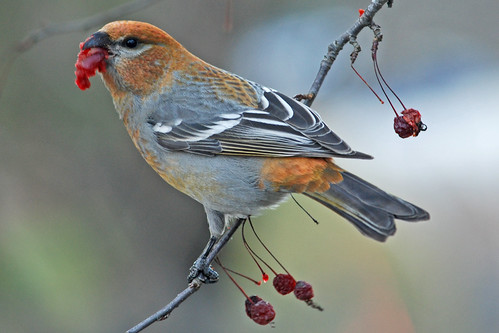 |
| Pine Grosbeak put in its first appearance since 2012 |
One of this year’s highlights was a Northern Flicker found in the Barre territory, only the 5th time recorded and the first since 2006. A lone Snow Bunting was our first since 2010. A Red-winged Blackbird in Plainfield-South territory was the 5th seen in the last 20 years, and the first since 2011. A total of 13 Pine Grosbeaks were seen in 3 territories, our first since 2012. Thanks in part to the owling efforts of Ken Benton, we set a new high count for Barred Owl of 4. Carolina Wren would have been unexpected 5 years ago, but has now become a regular occurrence with 1 individual found this year.
The most notable miss this year was Purple Finch, which had been seen every year since 2007. Purple Finches have become scarcer over the years, but after 252 reported last year, this was a disappointing miss. Other common species that were missed this year include Canada Goose, Hooded Merganser, and Pine Siskin. Only a single Ruffed Grouse was found in Lanesboro territory, a nice save considering we last missed Ruffed Grouse in 1985. Additional birds missed on count day but seen during count week were Northern Shrike, Bald Eagle, and Bohemian Waxwing.
The Plainfield count is blessed to have many passionate and dedicated volunteers, and this year we pay tribute to long-time volunteers Neil and Sharon Osborne. Together, they diligently covered a territory for the Plainfield CBC (most recently Hollister Hill) since 1989. After nearly 50 decades of enjoying birds with his wife Sharon, Neil passed away just this year. Neil had an incredibly keen eye and a passion for owls. Next time you hear or see a Barred Owl, be sure to remember Neil!
| Mallard | 41 |
| Common Merganser | 1 |
| Ruffed Grouse | 1 |
| Wild Turkey | 129 |
| Sharp-shinned Hawk | 1 |
| Cooper's Hawk | 1 |
| Bald Eagle | cw |
| Red-tailed Hawk | 1 |
| Rock Pigeon | 245 |
| Mourning Dove | 118 |
| Barred Owl | 4 |
| Downy Woodpecker | 26 |
| Hairy Woodpecker | 30 |
| Northern Flicker | 1 |
| Pileated Woodpecker | 2 |
| Northern Shrike | cw |
| Blue Jay | 90 |
| American Crow | 298 |
| Common Raven | 21 |
| Black-capped Chickadee | 807 |
| Tufted Titmouse | 13 |
| Red-breasted Nuthatch | 20 |
| White-breasted Nuthatch | 36 |
| Brown Creeper | 2 |
| Carolina Wren | 1 |
| Golden-crowned Kinglet | 7 |
| American Robin | 2 |
| European Starling | 55 |
| Bohemian Waxwing | cw |
| Cedar Waxwing | 6 |
| Snow Bunting | 1 |
| American Tree Sparrow | 38 |
| Dark-eyed Junco | 22 |
| Northern Cardinal | 29 |
| Red-winged Blackbird | 1 |
| Pine Grosbeak | 13 |
| House Finch | 12 |
| American Goldfinch | 88 |
| Evening Grosbeak | 73 |
| House Sparrow | 12 |




